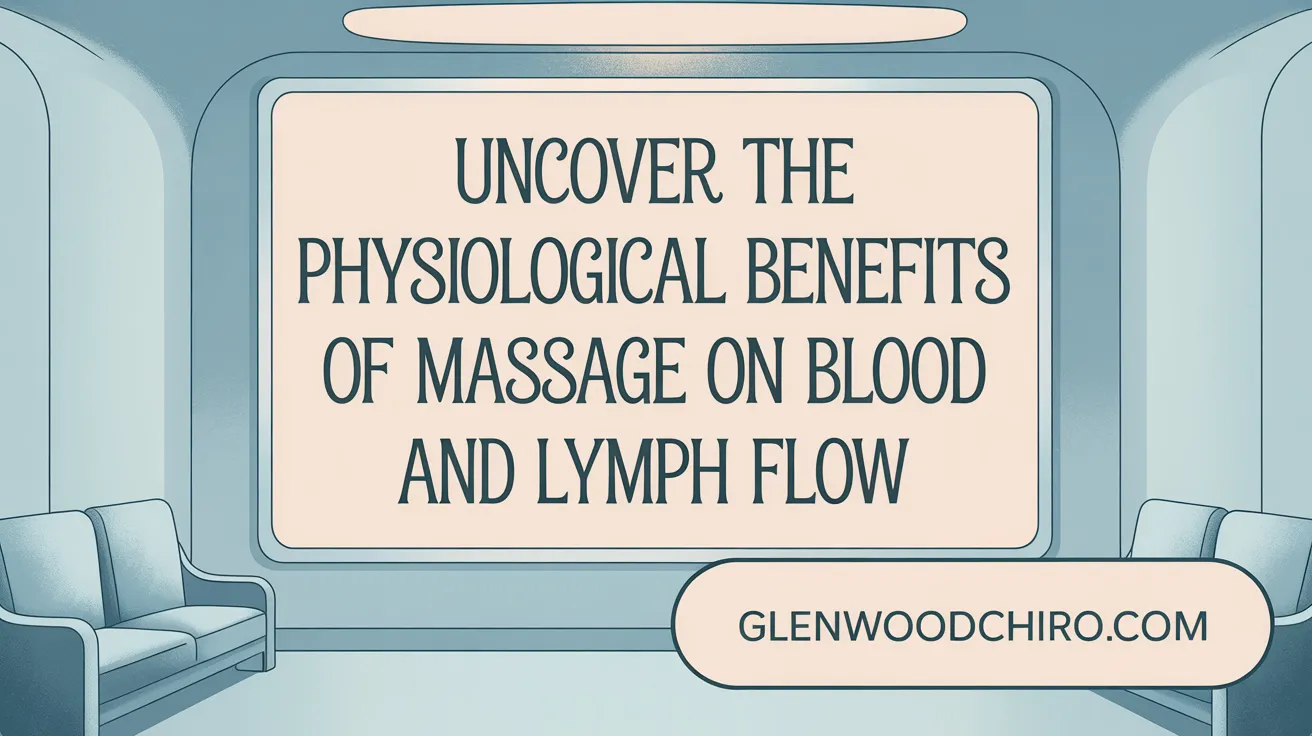Introduction to Massage Therapy's Role in Health
Massage therapy is more than a soothing experience — it is a scientifically supported practice that can significantly enhance blood circulation and accelerate the recovery process after physical activity or injury. This article explores the physiological mechanisms behind massage therapy, its effects on muscle and tissue repair, and the ways it supports overall well-being and athletic performance. Readers will gain insight into effective techniques and the current scientific evidence validating massage as a valuable health tool.
Understanding the Scientific Mechanisms Enhancing Circulation Through Massage
 Massage therapy improves blood circulation through a variety of interconnected physiological processes. One primary mechanism involves mechanical stimulation; when pressure and movement are applied during massage, it causes vasodilation— the widening of blood vessels— which increases blood flow to targeted areas. This mechanical pressure also elevates muscle temperature and arteriolar pressure, which helps in enhancing nutrient delivery and waste removal.
Massage therapy improves blood circulation through a variety of interconnected physiological processes. One primary mechanism involves mechanical stimulation; when pressure and movement are applied during massage, it causes vasodilation— the widening of blood vessels— which increases blood flow to targeted areas. This mechanical pressure also elevates muscle temperature and arteriolar pressure, which helps in enhancing nutrient delivery and waste removal.
Another crucial factor is the role of nitric oxide, a natural vasodilator produced by the endothelium (the lining of blood vessels). Massage techniques stimulate endothelial cells to release nitric oxide, promoting further vasodilation and improved blood flow throughout the body. This effect not only aids in faster tissue repair but also contributes to lowering blood pressure and supporting overall cardiovascular health.
Massage also influences the nervous system; it stimulates the parasympathetic branch, responsible for relaxation, which leads to decreased heart rate and blood pressure. This calming response not only enhances mental well-being but also supports systemic circulatory improvements. The relaxation of muscles reduces constriction around blood vessels, ensuring unobstructed flow.
Furthermore, massage facilitates venous return—the process of blood flowing back to the heart—by applying rhythmic pressure, which helps propel deoxygenated blood and metabolic waste products away from tissues. This combined effect of mechanical action, biochemical responses, and nervous system modulation creates a systemic boost in circulation. Overall, these mechanisms reinforce how massage therapy can positively impact blood flow, tissue health, and overall cardiovascular function.
Massage Therapy's Vital Role in Muscle and Tissue Recovery
How does massage therapy benefit muscle and tissue recovery after physical activity or injury?
Massage therapy plays a significant role in aiding the body's natural healing processes after exercise or injury. It helps reduce muscle soreness and inflammation by promoting better circulation, which facilitates the delivery of oxygen and essential nutrients to damaged tissues. This enhanced blood flow not only speeds up recovery but also helps flush out metabolic waste products like lactic acid, reducing discomfort and swelling.
The mechanical pressure exerted during massage increases muscle compliance and joint range of motion while decreasing stiffness. These physical effects restore normal muscle function and improve flexibility, making it easier for muscles to perform and recover. Moreover, massage techniques such as lymphatic drainage support immune responses, helping to clear inflammatory cells and cytokines from injured tissues.
Neural and hormonal effects also contribute to recovery. Massage influences neural excitability, activates the parasympathetic nervous system, and can decrease stress hormones like cortisol, while increasing relaxation-inducing chemicals such as serotonin and dopamine. These physiological changes promote relaxation and psychological well-being, which further supports healing.
Clinically, massage accelerates tissue regeneration by increasing muscle temperature, reducing swelling, and promoting immune activity. Techniques that target scar tissue and release tension in fascia improve mobility and prevent future injury. Despite limited evidence directly linking massage to an increase in muscle strength or athletic performance, it remains a vital element in holistic recovery strategies, combining physical, neural, and hormonal benefits to facilitate faster and more complete healing.
Effective Massage Techniques to Boost Circulation and Facilitate Recovery
 Various massage techniques for better circulation target blood and lymph flow, playing a vital role in enhancing overall health and recovery. Among these, effleurage is widely used for its gentle, long, gliding strokes that promote vasodilation and stimulate both blood and lymphatic circulation. This technique helps increase tissue warmth, reduce muscle tension, and facilitate the removal of metabolic waste like lactic acid.
Various massage techniques for better circulation target blood and lymph flow, playing a vital role in enhancing overall health and recovery. Among these, effleurage is widely used for its gentle, long, gliding strokes that promote vasodilation and stimulate both blood and lymphatic circulation. This technique helps increase tissue warmth, reduce muscle tension, and facilitate the removal of metabolic waste like lactic acid.
Petrissage, involving kneading or squeezing motions, further enhances circulation by mechanically stimulating blood vessels and encouraging venous flow back to the heart. Wringing and Swedish massage techniques employ rhythmic squeezing and comprehensive strokes, respectively, which help improve overall vascular movement and tissue compliance.
Lymphatic drainage techniques use light, rhythmic movements focused on specific lymphatic pathways to promote lymph flow from tissues to lymph nodes. This not only reduces swelling but also supports immune function and detoxification.
Each of these techniques contributes uniquely to boosting circulation. Effleurage and petrissage primarily increase blood flow, helping to deliver oxygen and nutrients to tissues while flushing out toxins. Lymphatic drainage complements this by improving lymph circulation, which reduces swelling and enhances immune responses.
Integrating these massage styles can optimize recovery, decrease muscle stiffness, and promote faster healing. For example, athletes often benefit from deep tissue massage or Pfrimmer therapy for physical recovery, combined with lymphatic drainage to manage swelling and support immune health. Ultimately, selecting the appropriate massage techniques tailored to individual needs can significantly magnify health benefits, expedite recovery, and boost overall well-being.
| Technique Name | Primary Effect | Best Used For | Additional Benefits |
|---|---|---|---|
| Effleurage | Stimulates blood and lymph flow | Relaxation, increasing circulation | Reduces muscle tension, warms tissues |
| Petrissage | Enhances vascular mobility | Decreased stiffness, deep relaxation | Promotes venous return, toxin removal |
| Deep tissue massage | Breaks down adhesions | Chronic tension, injury rehab | Increases oxygen supply, reduces pain |
| Lymphatic drainage | Activates lymph flow | Swelling, immune support | Detoxifies tissues, reduces puffiness |
Utilizing these techniques as part of a comprehensive recovery or health routine can lead to improved circulation, enhanced tissue health, and swift recovery from injury or fatigue.
Physiological Impact of Massage on Circulatory and Lymphatic Systems
 Massage therapy exerts significant positive effects on both the circulatory and lymphatic systems, which are essential for maintaining overall health and supporting recovery processes.
Massage therapy exerts significant positive effects on both the circulatory and lymphatic systems, which are essential for maintaining overall health and supporting recovery processes.
One of the primary physiological impacts of massage is the increase in skin and muscle blood flow. Techniques such as effleurage and petrissage promote vasodilation, or the widening of blood vessels, which allows more oxygen-rich blood to reach tissues. Studies have shown that massage can raise skin temperature and improve blood volume in targeted areas, thereby enhancing tissue vitality and accelerating healing.
In addition to boosting blood circulation, massage stimulates the lymphatic system, a crucial network responsible for waste removal and immune support. Gentle, rhythmic manipulations in lymphatic drainage massage encourage lymph fluid movement, helping to reduce congestion and swelling, particularly in conditions like lymphedema or chronic venous insufficiency.
This dual stimulation of blood and lymph flow supports detoxification by facilitating the removal of metabolic waste products such as lactic acid and cytokines, which are associated with inflammation and muscle soreness. Efficient waste removal and increased nutrient delivery restore tissues more rapidly and promote healthier skin and connective tissues. Massage also aids in flushing out lactic acid and metabolic waste, contributing to these benefits.
Moreover, massage-induced vasodilation and lymphatic activation contribute to improved vascular health and reduced inflammation. By promoting better circulation, massage can help prevent blood clots, lower blood pressure, and support overall cardiovascular function. The reduction in inflammatory mediators not only alleviates pain and stiffness but also supports the immune system's capacity to respond to injuries and infections.
In summary, massage therapy enhances the physiological functions of the circulatory and lymphatic systems through increased blood flow, improved temperature regulation, and effective lymph drainage. These mechanisms underpin the benefits of faster recovery, reduced swelling, detoxification, and overall tissue health, making massage a valuable complement to health and rehabilitative care.
Massage Therapy for Accelerated Healing, Performance, and Well-being

How does massage therapy accelerate healing and recovery in sports, injury rehabilitation, and chronic pain management?
Massage therapy plays a significant role in speeding up healing and recovery processes across sports, injury rehabilitation, and chronic pain management. It enhances blood flow and lymphatic drainage, which are crucial for tissue repair. Increased circulation delivers more oxygen and nutrients to injured tissues while facilitating the removal of metabolic wastes and inflammatory byproducts. This process helps reduce swelling, alleviate muscle knots, and disintegrate scar tissue, restoring normal muscle function, flexibility, and range of motion. Mechanical pressure during massage stimulates mechanoreceptors and neurochemical release, which promote relaxation, pain relief, and endogenous production of painkillers like endorphins. Additionally, massage lowers cortisol levels and enhances mood, supporting mental well-being. When integrated with techniques such as deep tissue or sports massage, it creates an optimal environment for tissue regeneration, faster recovery, and improved performance (massage therapy benefits).
In what ways does massage therapy reduce muscle soreness and fatigue while improving flexibility?
Massage reduces muscle soreness and fatigue primarily by increasing blood circulation, which helps flush out lactic acid and other metabolic waste products. This process decreases muscle stiffness, enhances tissue compliance, and promotes relaxation. By elevating muscle temperature and blood flow, massage also makes the muscles more elastic, improving flexibility and joint mobility. Neural effects of massage include dampening neural excitability and activating the parasympathetic nervous system, fostering relaxation, lowering perceived fatigue, and reducing anxiety. Post-exercise massage has been shown to lessen the severity of delayed onset muscle soreness (DOMS), supporting quicker physical and psychological recovery (post-exercise massage and muscle soreness). Overall, massage’s physical and neural effects combine to help muscles recover faster, with increased flexibility that benefits athletic performance and daily functioning.
What are the overall health benefits of massage therapy related to circulation and well-being?
Regular massage therapy confers multiple health benefits, especially by improving blood and lymph circulation. The rhythmic pressure and manipulations induce vasodilation, which enhances blood flow, supporting efficient oxygen and nutrient delivery while aiding in the removal of toxins. Improved circulation can lower blood pressure, reduce arterial stiffness, and decrease cardiovascular risks. Massage also reduces stress hormone levels such as cortisol while elevating mood-enhancing chemicals like serotonin and dopamine, leading to better mental health. Its calming effects activate the parasympathetic nervous system, fostering relaxation, reducing anxiety, and improving sleep quality. Collectively, these benefits promote overall physical health, emotional balance, and a stronger immune response, making massage a holistic approach to well-being (massage promotes well-being).
How can massage therapy aid in injury prevention and enhance athletic performance?
Massage therapy supports injury prevention by maintaining muscle elasticity, reducing tightness, and correcting imbalances. Increased blood flow enhances tissue nutrition and waste removal, which shortens recovery times and keeps muscles in optimal condition. Techniques such as sports massage and myofascial release target specific areas of tension, decreasing the likelihood of strains and tears. Furthermore, massage promotes greater flexibility and joint mobility, essential for peak performance and injury resistance. It also reduces muscle soreness, allowing athletes to train more effectively and recover faster between sessions. The relaxation effects, including decreased cortisol and increased parasympathetic activity, help improve focus and reduce anxiety. Although evidence varies, ongoing research suggests that regular massage is a valuable component of athletic training and injury prevention strategies (massage and injury prevention).
What scientific research and clinical studies support the effects of massage therapy on circulation and recovery?
A body of scientific research underscores massage therapy’s positive impact on circulation and recovery. Controlled studies show that massage techniques such as deep tissue massage increase microcirculation, leading to better oxygenation and removal of waste products from muscles. These benefits facilitate faster muscle healing, reduce stiffness, and improve flexibility. Clinical trials also document that massage stimulates the release of neurotransmitters like serotonin and endorphins, alleviating pain and stress. Moreover, studies utilizing flow-mediated dilation (FMD) measurements demonstrate systemic improvements in vascular function following massage, suggesting long-term cardiovascular benefits. Overall, evidence from randomized controlled trials consistently confirms massage therapy’s role in enhancing circulation, reducing soreness, and supporting rapid recovery in both clinical and athletic populations (research on massage mechanisms, massage therapy improves circulation).
Conclusion: Embracing Massage for Circulatory Health and Enhanced Recovery
Scientific understanding and clinical evidence validate the powerful role of massage therapy in boosting circulation and accelerating recovery. Through mechanical pressure, thermal effects, and neurological pathways, massage enhances blood and lymph flow, aiding tissue healing and reducing muscle soreness and fatigue. Targeted techniques such as Swedish, deep tissue, and lymphatic drainage massage each contribute uniquely to improving vascular and lymphatic function. Further benefits include enhanced flexibility, reduced inflammation, and psychological relaxation, supporting overall well-being and athletic performance. Incorporating regular massage therapy into health and recovery routines offers a natural, integrative approach to maintaining physical vitality and preventing injury. Continued research promises to deepen insights and optimize massage protocols, ensuring this age-old practice remains a cornerstone of modern therapeutic care.
